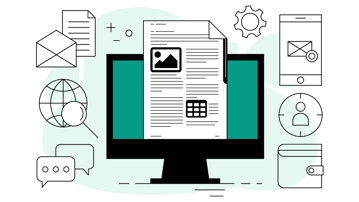With good management, teams can work faster, avoid errors, and improve their chances of winning.
Why Structured Bid Process Management Matters
In competitive industries like oil and gas, construction, or professional services, bidding is more than just submitting a number. It's a detailed, multi-step journey involving planning, coordination, and compliance. Done right, bid process management helps companies create strong proposals, reduce risks, and win more work.
Behind every successful submission is a clear management process—from identifying the opportunity to developing the response, all the way to final delivery.s
Getting Ahead in Tendering
The journey often begins before any official request for proposal (RFP) is published. Business development teams track contract cycles, client needs, and project forecasts to spot upcoming tenders early. CRM systems, market research, and industry events are all valuable sources of insight.
This early visibility allows teams to prepare internal resources and decide where to focus their time. Planning ahead also increases the chances of influencing client requirements before the tender is finalized—an advantage in competitive bidding environments.
Building a Bid Strategy That Works
When a likely opportunity is identified, the company must decide how to respond. This includes assessing client fit, technical capabilities, risk factors, and pricing strategy. Internal alignment is crucial here.
A strong bid strategy will define not just how to win, but whether to bid at all. Companies that manage their bids effectively don’t chase everything—they focus on what they’re best positioned to win.
Pre-Qualification: Your First Chance to Impress
Many tenders begin with a pre-qualification phase, where clients filter potential suppliers based on minimum requirements. These might include certifications, financial strength, technical experience, or past project performance.
This early stage should not be treated as a formality. A clear, complete pre-qualification response can position your company as a trusted bidder—and, in some cases, influence the structure of the final tender. It also shows that your team takes bidding and tendering seriously.
The Role of the Tender Manager
Once the tender documents arrive, coordination becomes critical. A dedicated tender manager is usually responsible for reviewing the documents, confirming submission requirements, and organizing the internal bid team.
This person acts as the hub for communication, compliance, and progress tracking. Their oversight helps reduce confusion and keeps the entire bidding process on schedule.
Assembling the Bid Response Team
A successful bid requires collaboration across departments. Typical contributors include sales, legal, finance, operations, and subject matter experts with deep technical knowledge. HSE and quality teams may also support where safety and compliance are priorities.
Holding a kickoff meeting early helps align everyone on goals, timelines, and responsibilities. This is a cornerstone of effective bid management—ensuring all voices are heard and every task is covered.
Creating Bids That Follow the Rules
As the writing begins, structure matters. Responses should follow the client's instructions exactly—whether that means using specific section numbers, file formats, or naming conventions.
Using bid management software or a shared file system ensures that everyone is working from the same version and that no details are missed. Maintaining an untouched copy of the original bid documents is also good practice, in case reference is needed later.
Answering Clearly and Compliantly
Strong bids are easy to read and fully responsive. It’s best to repeat the client’s question before writing your answer. This keeps responses focused and shows evaluators you’ve addressed each requirement directly.
Compliance is not just about what you say—it’s about how you present it. Consistent formatting, clear language, and properly labeled files all contribute to a professional and compliant submission that ensures compliance with the tender’s terms.
Writing the Executive Summary
Though not always required, an executive summary is a powerful tool. It explains why your company is the right fit, highlights your key differentiators, and gives evaluators a quick overview of your offer.
This summary also helps guide internal reviewers. It’s often drafted early and refined as the bid develops—supporting a clear message throughout the response.
Managing Time and Workload
Bids can be time-consuming. One proven approach is to divide the available time into three parts: one quarter for planning, half for writing and coordination, and the last quarter for reviews and approvals.
Without structured proposal management, teams often rush at the end—leading to mistakes or incomplete submissions. Regular check-ins and progress reviews help avoid that risk.
Preparing the Commercial Section
The pricing portion of a tender is more than a number. It must reflect your solution accurately, consider any risks or assumptions, and stay within the client’s pricing model.
If your company can’t meet all terms, you may need to include qualifications or propose alternatives. These should be reviewed carefully and kept to a minimum. Clients want clear, straightforward pricing that aligns with their expectations—and too many conditions can hurt your offer.
Finalizing the Bid Submission
The final delivery is just as important as the content. Whether you’re submitting through a digital portal or delivering hard copies, planning is essential.
Files must be named correctly, formats followed, and all required signatures included. Uploading early reduces the risk of technical issues. If using a courier, label everything as requested by the client and track delivery to ensure it's received on time.
Missing a deadline—even by minutes—can disqualify an otherwise winning bid.
Delivering a Professional, Compliant Proposal
By the time your team reaches submission, you’ve completed a complex, high-stakes project. Submitted proposals that are clear, compliant, and compelling don’t happen by chance—they’re the result of strong coordination and consistent bid process management.
This repeatable structure gives companies a real advantage in high-value tendering processes, helping them build trust with clients and increase win rates over time.
What Happens After You Submit the Bid
Submitting the final proposal might feel like the end—but for most tenders, it's just the start of the next phase. After receiving all bids, the client begins a structured evaluation process. This often involves multiple teams reviewing the technical, commercial, and contractual sections separately.
During this time, it’s common for the client to send out follow-up questions. These might clarify details, address inconsistencies, or explore specific parts of your proposal. Managing this stage well is crucial to maintaining momentum—and credibility.
Handling Post-Submission Clarifications
Every question from the client should be logged and answered through a single point of contact—usually the tender manager. This centralized approach avoids duplication and ensures consistency in responses.
Many clients maintain a clarification log. Your team should mirror this with your own internal log, carefully tracking each query and the corresponding response. Answers must be delivered on time and reflect the same professionalism and clarity as your original bid documents. Remember, this is still part of the evaluation, and how you respond can impact the final decision.
This is also when any qualifications in your bid may be challenged. For example, if you stated a pricing condition or limitation, the client may ask how your offer would change if that qualification is rejected. Being prepared with supporting explanations or alternatives is part of strong bid process management.
Preparing for Negotiations
In some cases, the client narrows down the list of bidders to one or two finalists. These companies are invited into negotiation meetings—either in person or virtual—to explore ways to improve their proposals.
Negotiations often focus on commercial terms, delivery timelines, or added value. Having a plan for this stage is essential. Your bid strategy should already outline your negotiation boundaries, pricing flexibility, and fallback positions. All discussions should be documented, with final outcomes agreed by both sides before they’re considered binding.
Well-managed negotiations not only help you win the work—they set the tone for the upcoming contract relationship.
The Award Notification
Once evaluations are complete and internal approvals secured, the client makes a decision. Successful bidders are typically notified first, often by email or in a scheduled meeting. Details of the award—including any clarifications or agreed terms—are included in this communication.
Unsuccessful bidders are notified later, usually after the winner accepts the contract. While not all clients offer feedback, most provide an opportunity for a debriefing, which can be invaluable for future bids.
Learning Through the Debrief
Whether you win or lose, a debrief gives your team insight into how your proposal was evaluated. This is an important part of continuous improvement in bid process management.
Go into the debrief with the goal of listening, not defending. Even if you disagree with the client’s evaluation, understanding their perspective helps you improve future submissions. If the feedback is limited, consider following up later through informal channels for more insight.
If you win, don’t skip the debrief. Learning what worked is just as important as learning what didn’t—and it gives you a blueprint to repeat your success.
Finalizing the Contract
Once awarded, the client drafts the contract based on your proposal and any agreed changes. This stage often involves your legal, commercial, and operations teams to review all final terms, schedules, and deliverables.
A thorough cross-check is critical. Ensure that all submitted proposals, clarifications, and negotiation outcomes are reflected in the final document. Errors or omissions can cause confusion—or disputes—during delivery. Each team involved should review the sections relevant to them, from pricing and penalties to invoicing terms and scope definitions.
Only after all discrepancies are resolved should the contract be signed. This is where precise project management helps ensure nothing gets missed.
Handover to Delivery Teams
After signing, the contract needs to be handed over to the people responsible for execution. A formal handover meeting is essential. It ensures the delivery team understands what was promised and what terms must be followed.
Key topics typically include deliverables, deadlines, invoicing rules, and performance incentives. This meeting often includes representatives from legal, finance, operations, and project management. Supporting materials like presentations, signed documents, and planning spreadsheets should be archived for future reference—especially if the client conducts audits or performance reviews later.
Managing Long-Term Contracts
For multi-year or high-value contracts, post-bid responsibilities continue long after the initial handover. Contracts often include clauses for price adjustments, scope changes, or option periods where the agreement can be extended.
To maintain alignment, many companies hold annual contract reviews. These ensure new team members are briefed, project changes are tracked, and any contract amendments are properly documented. Formal updates—like variation orders or contract addenda—must be signed by both parties to be valid.
Staying proactive here is another sign of successful bid management.
Why XaitPorter Is Built for Bid Process Management
The entire bidding lifecycle—from tracking opportunities to final handover—is complex and deadline-driven. Coordinating inputs from multiple departments while meeting client requirements takes more than just Word and Excel. That’s where XaitPorter comes in.
XaitPorter is a cloud-based bid management software designed specifically for teams working on complex bids and proposals. It helps companies:
- Create bids faster, using shared templates and real-time collaboration
- Ensure compliance by controlling document structure, layout, and access
- Streamline approvals with built-in workflows and version tracking
- Align subject matter experts, no matter where they’re located
- Deliver consistent, branded documents every time
Because it’s built for co-authoring, XaitPorter eliminates the chaos of document merging and manual formatting. Teams can work in parallel while still producing a single, polished final product. It supports everything from technical responses to executive summaries and pricing models—ensuring your team never misses a requirement.
For companies that want to professionalize their bidding process and scale their ability to respond to more tenders—without increasing overhead—XaitPorter is a strategic investment.
It’s more than a document tool. It’s a purpose-built platform for teams who want to win more, stress less, and master the art of proposal management.












